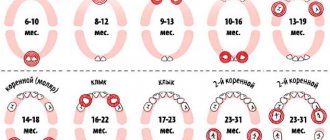We will talk about canines - powerful single-rooted teeth with serial number 3, located in pairs in the upper and lower jaws between the front incisors and premolars. The term “eye teeth” appeared in parallel as a common one, primarily among dentists themselves. There is even a diagnosis of “eye tooth”, and it is made by doctors when the child’s fangs begin to grow, accompanied by a distinct pain syndrome.
Because the roots of these teeth are located in close proximity to the facial and optic nerves, this growth may be accompanied by pain in the eyeballs. And the removal of such a tooth is also fraught with unpleasant sensations in the eye area. True, rumors that you can go blind after surgery related to these teeth have no basis.
Among non-specialists, the name “eye teeth” is used due to the fact that if you mentally continue the axis of such a tooth upward, it will pass right along the corner of the eye, which can be seen by stretching your lips and exposing your fangs in a grin.
Eye teeth are just fangs
Yes, the truth is precisely that “eye teeth” are nothing more than ordinary fangs, which are present in the same quantity as in the primary occlusion, i.e. in a child, and permanently in an adult. They are located on the upper and lower jaw between the incisors and molars (two units above and two units below). Dental experts call them “threes.” These teeth are single-rooted. Those on top “crawl” through the jawbone a little earlier than their lower counterparts.
The approximate timing of eruption for eye teeth is in the primary dentition of a child from 15 to 20 months from birth (from about one and a half years), in the permanent dentition - from 8 to 10 years.
Now you understand that “eye teeth” are not at all some pathological elements of the dentition. And their appearance is considered a natural process for absolutely all people on earth and is not at all associated with deviations or anomalies in development. In appearance, the fangs also do not look scary; they have a pointed shape towards the bottom (they are more elongated than the neighboring incisors), which helps us literally “cut off”, tear off and bite off food. Look at the photo - this is exactly what they look like.
In the photo you can clearly see the difference between ordinary incisors and canines
Eruption of canines affects the optic nerve
Although the fangs are single-rooted, their roots are longer than those of their neighbors. Due to its anatomical location and structure of the maxillofacial system, it affects the ocular and facial nerves. Namely, the facial nerve, in turn, is responsible for transmitting impulses from the central nervous system of our body to the upper part of the face. That is why, during their eruption, such teeth can cause a lot of discomfort in the baby and even pain in the eyeballs. Now do you understand why these units are popularly called “ocular”?
Branching of the trigeminal nerve
Pain after dental implantation, tooth implant hurts
During dental implantation, the trigeminal nerve and its branches, the alveolar nerve plexus, may be damaged as a result of:
- Screwing the implant into the canal where the trigeminal nerve or its branches lies;
- Inflammation in the implant area (infection and/or implant rejection).
Some pain during the implant healing process is normal. If the pain after dental implantation lasts too long, is very severe, or is accompanied by numbness of the lip or cheek, we can check the condition of the trigeminal nerve using electromyography and a neurological examination based on the characteristic loss of facial sensitivity and the spread of pain along the trigeminal nerve system.
The rejection reaction and inflammatory processes in the implant area are usually clearly visible with CORRECT X-ray examination and computed tomography.
Implants in the lower and upper jaw. Pain after dental implantation
There may be direct pressure from the implant on the nerve or inflammation in the implant area with tissue swelling, edema and subsequent pressure on the nerve.
Eruption of eye teeth is difficult and painful
We all know that during the period of primary teething, our babies need special attention and approach. Often this period of time causes a lot of concern among parents due to the child’s capriciousness, the desire to put foreign objects into the mouth and bite, loss of appetite, and the appearance of other warning symptoms: diarrhea, runny nose and cough, increased body temperature. But it is acute painful sensations that most often accompany the appearance of “eye teeth” in children.
If during this period of time an infection is added to all the above symptoms, which attacks the baby’s weakened body, exhausted by such stress, then not only the mucous membrane surrounding the future tooth may become inflamed, but also the optic nerve. As a result, the eyes will become sore, conjunctivitis will appear, the baby will begin to react poorly to bright lighting, and tears will also flow heavily.
The eruption of such teeth can cause a lot of discomfort in the baby and even pain in the eyeballs.
What other symptoms can increase significantly during the period of eruption of “eye teeth” in a child (compared to other units):
- body temperature almost always rises: the high temperature in this case can last longer than expected - not 2-3, but sometimes all 3-5 days,
- a cough and runny nose will appear: be careful here, because this sign may indicate not only an increased secretion of saliva, which often accumulates in the baby’s mouth and enters the nose when lying down, but also a possible weakening of the immune system and the development of ARVI against this background,
- Severe swelling and inflammation of the soft tissues occurs: if oral hygiene is improper during this important period, the baby may develop gingivitis.
Monitor your baby closely; in case of alarming symptoms (vomiting, persistent fever, diarrhea) or suspicion of ARVI, be sure to call a doctor. Otherwise, teethers, pacifiers (preferably orthodontic), antipyretics (Nurofen), anti-inflammatory creams and ointments like Kamistad Baby, Kalgel, adjusting the temperature in the baby’s room and eliminating any allergens ( dust, wool, plants). You can also use Viburkol suppositories to normalize the baby’s general condition and well-being.
Kamistad baby drug
“On the general symptoms of the eruption of “complex” teeth, which include “eights” (wisdom teeth) and “threes”, i.e. fangs, quite strongly affects the child’s immunity. If it is consistently strengthened from the very moment of birth, then in most cases, when babies erupt, they do not have problems such as upset stool, fever, or poor health,” says dentist-therapist N.G. Boyko.
Localization and nature of toothache
It's hard to go wrong with a sore mouth. A person can easily describe where and what hurts. Painful sensations can differ both in intensity (sharp and strong or weak and aching) and frequency (for example, at night - that’s another test). Toothache can affect one tooth or several in a row, on one or both jaws. The pain can radiate to the temple, affecting not only the eye and ear, but also causing migraines. Moreover, the trigger (trigger mechanism) for such sensations is not necessarily hot tea or cold ice cream. Sometimes a person describes their occurrence as “out of the blue.”
Let's try to summarize the types of toothache:
- Aching, sensations are dull and not intense.
- Shooting, sharp, in the form of sharp impulses, causing suffering.
- Sharp, unexpected, independent of the time of day.
- Long-lasting, “background”, tolerable, so the patient puts off seeing a doctor.
Each of the above types of pain indicates a particular pathology. With a timely visit to the dentist, there is every chance of maintaining a beautiful smile and healthy teeth. Otherwise, unpleasant consequences will not keep you waiting.
“Eye teeth” are resistant to destructive processes
“Eye teeth” in both children and adults are considered one of the strongest, even though they are of the same root. All this is due to their shape, smoothness, absence of pits and depressions on the surface, as well as a fairly thick layer of dentin. They are rarely susceptible to caries or other damage, but this does not mean that they do not need care. Even the very first units that erupt should be cleaned using special wipes and silicone finger brushes. As your child grows, teach him how to independently use a soft-bristled brush and non-abrasive paste for oral hygiene. And remember, if there are bacteria in the mouth, then sooner or later even the fangs will not withstand their pressure.
It is important to teach your child oral hygiene from early childhood.
The eye units in some children grow crooked or occupy an incorrect position on the jaw, “climbing” onto their neighbors. Previously, in such a situation, doctors suggested removing them, but today the problem is successfully solved by orthodontists and devices that correct the bite.
How to choose a teether
In pharmacies you can find miniature ergonomically shaped structures made of silicone, latex, rubber and plastic. It is noteworthy that there are universal models, as well as those that are intended exclusively for civil protection.
Requirements for such products:
- safety (it is better to purchase teethers from well-known brands);
- It is better to refuse products that are too small or, conversely, too large - they are extremely inconvenient to use.
Pharmacy teethers made of latex, plastic, rubber make it possible to facilitate the process of “giving birth” to a child’s fangs.
Removing eye units is challenging
Not only teething, but also the removal of fangs, and even their absence, cause certain difficulties. For example, the procedure for removing fangs itself is considered quite difficult; after it, severe swelling, pain, the development of an inflammatory process, and even deterioration of vision are possible if the optic nerve is damaged (due to traumatic removal or complications during the recovery period after the procedure). And the absence of “eye teeth” and their untimely restoration can make it difficult to pronounce certain sounds, which will impair diction and speech.
Removing fangs is a rather complicated procedure.
Also, do not forget that the fangs are located in the frontal zone of the smile, so their absence will directly affect the aesthetics of the entire face. In addition, it is the canines that serve as excellent support for the orbicularis oris muscle; if they are missing, the muscle around the mouth will become flabby and increase age.
Notice
: Undefined variable: post_id in
/home/c/ch75405/public_html/wp-content/themes/UltraSmile/single-item.php
on line
45 Notice
: Undefined variable: full in
/home/c/ch75405/public_html/wp-content /themes/UltraSmile/single-item.php
on line
46
Rate this article:
( 3 ratings, average: 5.00 out of 5)
prevention
Consulting specialist
Chorny Stanislav Vladimirovich
Doctor rating: 9.8 out of 10 (4) Specialization: Orthopedist Experience: 19 years
Treatment of inflammation of the trigeminal nerve
The first stage of treatment for inflammation of the trigeminal nerve is medication. It is aimed at reducing the strength and frequency of pain in the patient. Most often, doctors prescribe anticonvulsants to a patient suffering from trigeminal neuralgia. Sedatives are also used.
Physiotherapeutic procedures, as well as resorption therapy to relieve the inflammatory process, have a good therapeutic effect. Next, the doctor may recommend the use of laser treatment, in which the laser is directed cutaneously to the area where the processes of the trigeminal nerve exit the skull.
Our clinic is located in the same building as the multidisciplinary clinic “Diamed on Shchelkovskaya”, where special conditions for receiving physiotherapeutic procedures are organized for dental patients. The clinic’s physiotherapy room is equipped with modern equipment, including a laser physiotherapy device, with which you will feel relief after the first procedure. The pain will go away and you can return to normal eating. Make an appointment with a dentist by calling 8 or using the online appointment form. The doctor will make an accurate diagnosis and refer you for treatment.
If you are in severe pain, but for some reason you have not yet made an appointment with us, then it can be relieved with folk remedies. Take one tablespoon of yarrow, pour a glass of boiling water, let it brew for one hour and strain. The tincture should be taken one tablespoon before meals three to four times a day.
Comments
My fangs stick out terribly, they seem to be incredibly long, like a vampire's, sticking out and pushed forward. I don’t like it, I’m embarrassed to smile because of them. Tell me, is it possible to somehow correct the situation, maybe file them down?
Marina (01/20/2019 at 08:56 pm) Reply to comment
- Dear Marina. The most correct decision for you will be an orthodontist, who, based on your situation, will select the appropriate corrective device option. If the fangs are healthy, then there is no need to file them down or put a crown on them, for example. Also, most likely it will not be possible to install a veneer, because... in case of significant deviations from the norm, this lining will not be able to solve the problem, and the tooth enamel will have to be greatly ground down, which is completely useless if it is healthy and intact. Consult with several doctors so that you can choose the best solution for your problem.
Editorial staff of the portal UltraSmile.ru (01/23/2019 at 08:24) Reply to comment
The article is useful for understanding those who do not know anything about eye teeth. And this is a simple explanation, fangs around the edges. Do I understand correctly that the eye teeth need to be removed if there is curvature of the fangs?
Peter (01/30/2019 at 08:29) Reply to comment
The child's eye teeth have erupted. How painful it is, I remember how it was when I was a child. Can fangs hurt from time to time and what do you recommend to do so that my daughter stops experiencing pain?
Raisa (01/30/2019 at 08:47) Reply to comment
I'm anxiously awaiting the baby's eye teeth. Two molars came out at the same time. Three days of fever and diarrhea. Viburkol suppositories do not help much. Maybe there are other candles so that they are also not very harmful?
Ekaterina (01/31/2019 at 14:04) Reply to comment
- Ekaterina, you should definitely contact your pediatrician. You can’t just choose candles based on useful tips posted on the Internet. For our part, we try to do only reviews of drugs, but we still insist that readers use them as prescribed by doctors. Especially when it comes to young children.
Editorial staff of the portal UltraSmile.ru (01/31/2019 at 14:21) Reply to comment
Recently, the child’s eye teeth began to appear. The child became restless. He doesn't sleep well at night. The temperature began to rise and diarrhea began. Well, for us it doesn’t last long, only three days.
Anastasia (02/12/2019 at 11:52 am) Reply to comment









